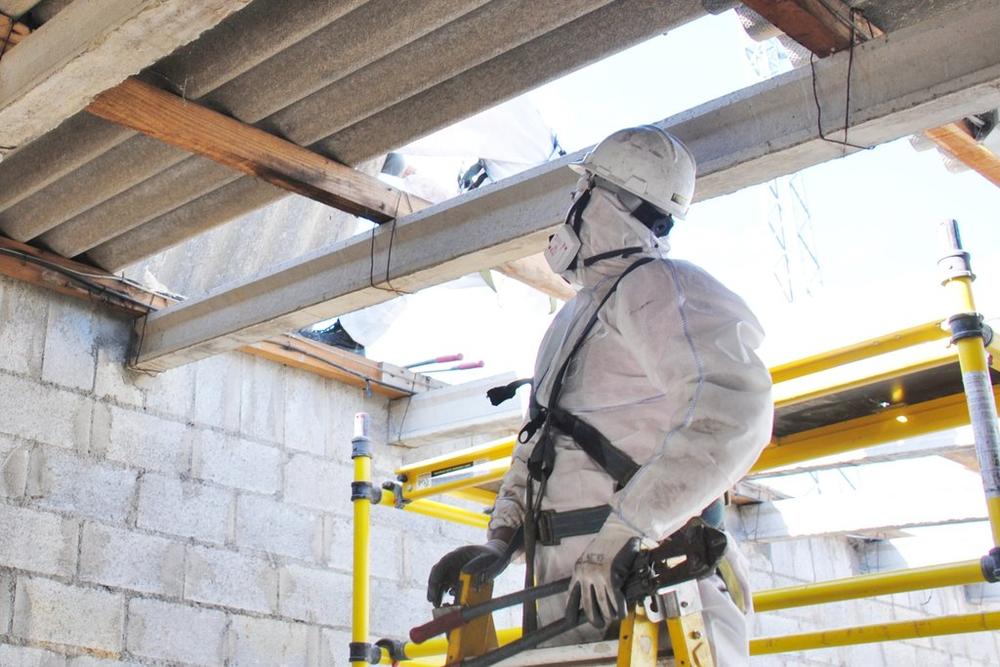Asbestos Testing: Essential Actions for a Safe Living Atmosphere
Asbestos Testing: Essential Actions for a Safe Living Atmosphere
Blog Article
The Complete Process of Accredited Asbestos Evaluating to Make Certain Building Compliance
In the world of home monitoring and compliance, the process of accredited asbestos screening stands as an essential part to make sure the safety and health of owners. Understanding the detailed actions entailed in this testing procedure is extremely important for residential property owners and managers alike. From the first assessment to the last interpretation of results, each stage plays a crucial duty in identifying the existence of asbestos within a home. Allow's explore exactly how this thorough process unfolds to assure adherence to stringent regulations and safeguard against prospective carcinogen.
Accredited Asbestos Screening: Preliminary Evaluation
In carrying out the first evaluation for approved asbestos testing, a thorough evaluation of the building's materials is vital to accurately recognize prospective asbestos-containing materials. Unique interest is offered to materials that are prone to harm or disturbance, as these situations can launch damaging asbestos fibers into the air.
Recognized asbestos assessors follow rigorous procedures established by governing bodies to ensure the accuracy and dependability of the screening process. By diligently documenting searchings for and utilizing innovative testing approaches, assessors can offer homeowner with a detailed record describing the visibility of asbestos, if any, and the suggested actions for mitigation or elimination. This initial evaluation establishes the foundation for subsequent actions to attend to asbestos worries and make certain the safety and security and compliance of the home.
Example Collection Procedures for Asbestos Evaluating
Effective example collection treatments are crucial in making sure exact asbestos screening results and compliance with regulative criteria. When accumulating examples for asbestos screening, it is crucial to follow stringent procedures to decrease the threat of contamination and make sure the reliability of the outcomes.
To start with, it is very important to determine the thought asbestos-containing products (ACMs) and focus on tasting areas based on elements such as the product's condition, access, and possibility for disruption. Asbestos Testing. Samples need to be gathered from various areas within the residential property to offer an extensive assessment of asbestos presence
Throughout sample collection, accredited professionals must use suitable personal safety tools (PPE) to secure against asbestos exposure. They must make use of clean devices, such as disposable gloves and plastic sheeting, to avoid cross-contamination in between samples. Examples need to be carefully collected making use of a specified strategy, such as wet cleaning or coring, and securely secured in closed containers to maintain their integrity throughout transportation to the lab for analysis.
Lab Analysis Refine for Asbestos Examples
Upon completion of the example collection process, the asbestos samples are diligently moved to recognized laboratories for meticulous analysis. The initial action in the lab evaluation process is example prep work, where the gathered examples are meticulously refined to remove the asbestos fibers.

Once the analysis is full, a detailed report is produced, detailing the searchings for and confirming whether click to read more asbestos exists, the sort of asbestos fibers determined, and the focus degrees. This details is critical for homeowner to take the required actions to ensure compliance with asbestos policies and protect the health and wellness of passengers.

Coverage and Analysis of Asbestos Test Outcomes
Recognized asbestos testing laboratories supply detailed reports that use crucial insights right into the visibility, kind, and focus degrees of asbestos fibers located in samples accumulated from homes. These reports are necessary for residential property owners and supervisors to understand the threat presented by asbestos and make notified choices regarding its administration or removal. The reports usually consist of details on the approaches used for screening, the areas from which examples were taken, the type of asbestos determined (such as chrysotile, amosite, or crocidolite), and the focus levels of asbestos fibers spotted.
Interpreting these results calls for expertise to examine the potential health and wellness risks connected with asbestos direct exposure, identify the proper strategy, and make sure regulatory conformity (Asbestos Testing). Depending upon the findings, recommendations might vary from continued surveillance and maintenance to encapsulation or complete asbestos reduction. Building owners should carefully assess these reports and consult with asbestos specialists to create a detailed plan for resolving any kind of asbestos issues determined
Making Sure Building Compliance With Asbestos Regulations
To keep adherence with asbestos regulations, residential or commercial property owners need to diligently execute steps to make certain compliance with appropriate laws and guidelines. This includes conducting routine asbestos examinations by recognized professionals to determine any type of presence of asbestos-containing products within the home. Once asbestos is determined, home owners should comply with asbestos administration plans that outline appropriate containment, removal, or encapsulation procedures visit the site to avoid direct exposure and spread of asbestos fibers. Compliance likewise entails keeping in-depth documents of asbestos testing, maintenance, and removal tasks for examination purposes.
Homeowner need to provide asbestos recognition training to workers and occupants to minimize the risk of asbestos direct exposure and make sure correct handling of materials that may have asbestos. Additionally, it is essential to stay notified about any updates or changes in asbestos regulations to readjust monitoring practices appropriately. By proactively addressing asbestos compliance needs, homeowner can develop a safe atmosphere for owners and mitigate potential legal and wellness threats related to asbestos exposure.
Conclusion
Finally, approved click this link asbestos testing is a vital process for ensuring building conformity with policies. The first evaluation, sample collection treatments, research laboratory evaluation, and analysis of outcomes are very important action in this procedure. By following these treatments, homeowner can determine and address any type of asbestos hazards existing, protecting the health and wellness of owners and maintaining compliance with regulative needs.
Report this page